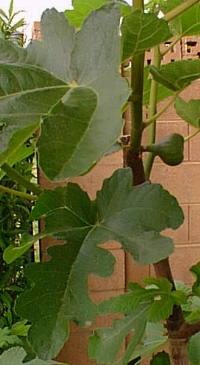Sunset®: 4-9, 12-24
USDA: 8-10
Frost Tolerance: Hardy to 10°F (-12°C)
Sun Exposure: Full Sun
Origin: Asia Minor
Growth Habits: Deciduous trees10-30 feet (3-9 m) wide spreading. Can be kept to any size by trimming.
Watering Needs: Water young trees regularly until fully established, Established trees need occasional deep watering in summer.
Propagation: Cuttings, budding, grafting
Propagation: Cutting or occasionally layering
- by stem tip cuttings, in early summer. Use intermittent mist. Root in 6-10 weeks. Allow cuttings to bleed overnight..
- by layers.
The cultivated Fig, native to the arid region of Asia Minor, forms a shrub or low-spreading deciduous tree. The large, wavy-margined leaves are usually 5 lobed but may have only 4 or 3 lobes. The leaves are conspicuously palmately veined, especially so on the under surface.
The best varieties for Phoenix are:
Brown Turkey (also known as Black Spanish, San Pedro): Good garden tree, large brownish purple fruit, better fresh.
Conadria: Medium greenish yellow skin with a purplish tinge, strawberry colored flesh, good fresh, excellent dried.
Kadota: No breba crop, medium greenish yellow skin, amber flesh, excellent fresh, excellent dried.
Mission (also known as Black mission): Large purple black fig, excellent fresh, excellent dried.
Blooming Habits:
The small flowers are produced twice in the season. The first ones (the breba crop) are produced near the ends of the shoots of the preceding flush of growth, whereas the second crop (the main crop) is produced in the axils of the leaves on the new growth.
Fruiting Habits:
The mature fruit is pear shaped and variable in size and color depending on the variety. The edible fruit is a hollow succulent receptacle with many ovaries on the inner surface, which may or may not produce seeds, again depending on the variety.
Figs are consumed fresh, and after sun or artificial drying. They have been an important fruit of commerce in the eastern Mediterranean region since antiquity, and today are grown in many parts of the world. Figs have a high sugar content and are a fair source of vitamins A, B, and B2. The process of pollen transfer and subsequent fruit set is unusual and complex, since flowers of edible figs do not produce pollen.
The pollination requires pollen from a kind known as caprifigs. The pollen is transferred from the caprifig to the edible fig by a wasp. Without the caprifigs and the wasps (in the USA for instance) varieties requiring fecundation will not set fruit. Fortunately the varieties found in the USA produce fruit parthenocarpically (I.e. without fecundation).
Culture:
Fig trees are tolerant of poorly drained soils and grow well in relatively infertile soils. They grow much better with a monthly fertilizing program and deep watering twice a month in summer. Too much nitrogen will produce much growth, but no fruit.
Propagation:
Fig trees are readily propagated by dormant hardwood cuttings, but budding or grafting also has been used to topwork a tree to a better variety. To propagate a fig tree by hardwood cutting, after the trees has lost its leaves (preferably at the end of December at the latest), select 8 to 12 inches shoots (20 to 30 cm), and bury them so that only a few node are out of the ground. By the end of the following year they should be established. They can take a while before building a decent root system. and the fact that they have green, apparently thriving leaves should not fool you.
Desert-Tropicals is dedicated to provide gardening advice, gardening ideas, and information about flower of all kind for landscape and collections.We try to check carefully the identification of the plants on the illustrations as well as the other information from the page, but occasionally errors do occur. if you notice anything that needs to be changed please contact us.Thanks.
© 1998-2020 Philippe Faucon, All Rights Reserved.
